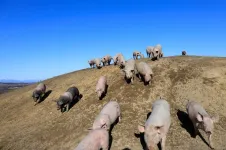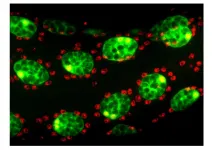INFORMATION:
Seismic coda used to locate and define damage from explosions
2021-04-06
(Press-News.org) Comparison of coda waves, the scattered waves that arrive after the direct waves of a seismic event, can be used to determine the relative locations of two underground explosions, according to a new study published in the open-access journal The Seismic Record.
The technique, called coda wave interferometry, was tested on explosions conducted as part of the Source Physics Experiment (SPE). Lawrence Livermore National Laboratory researchers Sean Ford and Bill Walter report that coda wave interferometry can also put a limit on the extent of damage caused by an explosion.
The findings suggest the technique could be used to improve the estimates of the relative locations of larger explosions, such as the series of announced nuclear tests conducted by the Democratic People's Republic of Korea over the past two decades.
"Based on the size and frequency scaling that we were able to employ in the paper and successes at SPE," said Ford, "a conclusion point is that this technique could be used for larger explosions at larger separations recorded at more distant stations" such as those used to monitor North Korean testing.
Unlike the direct and strong P- and S-seismic waves produced by an earthquake or explosion event, coda waves arrive later and are more sensitive to scattering by the rock that they pass through. Any changes in the scattering structure--from rocks pushed or crushed by an explosion, for example--"will show up in how these later arriving waves have bounced around in that medium over a greater duration," Ford explained.
In the new study, Ford and Walter used data from the SPE, an ongoing multi-institutional project involving Lawrence Livermore, Los Alamos and Sandia National Laboratories at the former Nevada nuclear test site. The SPE conducts chemical explosions to better understand the seismic waves they produce and to refine explosion detection techniques, using the analyses to improve monitoring of global nuclear explosions.
The researchers used coda wave interferometry to determine the known relative location of two chemical explosions that took place during Phase I of the SPE. The first explosion, SPE-1, was equivalent to 87.9 kilograms of TNT. The second explosion, SPE-2, was equivalent to 997 kilograms of TNT.
Their analysis concluded that the two explosions were located between 6 and 18 meters apart, and most likely 9.2 meters apart. The known separation between the two explosions is about 9.4 meters apart.
Previous research by seismologists David Robinson and coworkers, showed that coda wave interferometry could precisely locate earthquakes separated by hundreds of meters. "We were confident that the approach would work for chemical explosions, but the question for us was whether it could work for such small and closely located explosions," said Ford.
Ford and Walter also used the technique to better characterize the underground damage caused by SPE-2, comparing its coda waves with those produced by the 905-kilogram TNT equivalent SPE-3 that was later detonated in the same spot as SPE-2.
The details of the damage "can't be seen from the direct waves arriving at the [1-kilometer or more] distant stations that we're used to, so we thought perhaps we could see it in these more sensitive scattered waves, the coda waves," Ford explained
Based on the analysis, the damage caused by SPE-2 must have been confined to a spherical region with a radius less than 10 meters, the researchers concluded.
"We thought there would be much more damage, or at least more of an effect on the outgoing waves, but now there is evidence against that hypothesis, so this points us in other directions to explain the observed P- and S-waves," Ford said.
The study is the first research paper published in The Seismic Record, a new short-form, open-access journal from the Seismological Society of America.
ELSE PRESS RELEASES FROM THIS DATE:
Small cell lung cancer: Scientists identify two new approaches for therapy
2021-04-06
Using samples of small cell lung tumours, a research team led by biologist Dr Silvia von Karstedt has discovered two new ways to induce tumour cell death. One of two subsets of tumour cells can be targeted by activating ferroptosis: iron-dependent cell death caused by oxidative stress. In the second subtype, oxidative stress - and hence cell death - can also be induced in a different way. Both types of cell death must be triggered simultaneously by drugs to kill the majority of the tumour mass. The results of the study have been published in Nature Communications.
Despite many advances in treatment, a diagnosis of small cell lung cancer means a particularly poor prognosis. In Germany, up to 8000 new cases ...
Being top baboon costs males their longevity
2021-04-06
DURHAM, N.C. -- Some guys have it all: the muscle, the power, the high social status, the accelerated aging.
But wait. Faster aging? Who wants that? For male baboons, it's the price they pay to be at the top.
New research appearing April 6 in eLife by Jenny Tung, associate professor of evolutionary anthropology and biology at Duke University, and her colleagues shows that male baboons that climb the social ladder age faster than males with lower social standing. If a male drops in social status, his estimated rate of aging drops as well.
Using blood samples from 245 wild baboons in the ...
Moffitt researchers demonstrate tissue architecture regulates tumor evolution
2021-04-06
TAMPA, Fla. -- Tumors are genetically diverse with different mutations arising at different times throughout growth and development. Many models have tried to explain how genetic heterogeneity arises and what impact these alterations have on tumor growth. In a new article published in Nature Communications, Moffitt Cancer Center researchers show how the location of the tumor and spatial constraints put on it by the surrounding tissue architecture impact genetic heterogeneity of tumors.
Genetic differences are apparent among tumors from different patients, as well as within different regions of the same tumor of an individual patient. Some of these mutations may benefit the tumor and become selected for, such as mutations that allow the tumor to grow faster and spread to other ...
Hubble spots double quasars in merging galaxies
2021-04-06
NASA's Hubble Space Telescope is "seeing double." Peering back 10 billion years into the universe's past, Hubble astronomers found a pair of quasars that are so close to each other they look like a single object in ground-based telescopic photos, but not in Hubble's crisp view.
The researchers believe the quasars are very close to each other because they reside in the cores of two merging galaxies. The team went on to win the "daily double" by finding yet another quasar pair in another colliding galaxy duo.
A quasar is a brilliant beacon of intense light from the center of a distant galaxy that can outshine the ...
Breast cancer survivors' fear of cancer returning linked to genomic testing, psychological factors
2021-04-06
Breast cancer survivors with a higher risk of cancer recurrence based on genomic testing may experience greater fear of their cancer returning, according to a new study led by researchers at NYU Rory Meyers College of Nursing. However, psychological factors such as anxiety are the best predictors of survivors' fear of their cancer recurring.
"Although genomic test results were associated with fear of cancer recurrence, our findings highlight that distressing, but treatable, psychological factors fuel cancer survivors' fear of recurrence," said Maurade Gormley, PhD, RN, an assistant professor and faculty fellow at NYU Meyers and the lead author of the study, which was published in the journal Psycho-Oncology.
For breast cancer survivors, fear and worry that ...
Competing for high status speeds up aging in male baboons
2021-04-06
Battling other male baboons to achieve high social status comes with physiological costs that accelerate aging, according to study published today in eLife.
The findings suggest that current life circumstances may be more important contributors to premature aging than early life hardship, at least in baboons.
Chemical changes to DNA, also called epigenetic changes, can be used as a kind of 'clock' to measure aging. While these epigenetic changes usually correspond with age, they can also be used to detect signs of premature aging.
"Environmental stressors can make the clock tick faster, so that some individuals appear biologically older than their actual age and ...
Digital breast tomosynthesis reduces rate of interval cancers
2021-04-06
OAK BROOK, Ill. - Screening with digital breast tomosynthesis (DBT) reduces the rate of interval breast cancers compared to screening with digital mammography, according to a study published in Radiology. The study adds to a growing body of evidence supporting DBT as a breast cancer screening tool with important advantages over mammography.
DBT works by capturing a series of X-ray images of the breast from different angles. Previous research has shown that it has a higher sensitivity for breast cancer detection than digital mammography.
The impact of these additional DBT-detected cancers is not fully understood. ...
Chest CT illuminates mortality risk in people with COPD
2021-04-06
OAK BROOK, Ill. - Body composition information derived from routine chest CTs can provide important information on the overall health of people with chronic obstructive pulmonary disease (COPD), including their risk of all-cause mortality, according to a study published in Radiology.
COPD is a group of chronic, progressive lung diseases like emphysema and chronic bronchitis that affect about 30 million people in the United States alone. It is frequently associated with obesity and sarcopenia, a loss of muscle mass and strength. Obesity is associated with lower mortality in patients with COPD. The longer survival rates of obese patients compared to leaner counterparts, a phenomenon ...
Japanese consumers more concerned about gene-editing of livestock than of vegetables, survey shows
2021-04-06
A statistically rigorous survey of Japanese consumers has found that they have more negative opinions about the use of new gene-editing techniques on livestock than they do about use of the same technologies on vegetables.
The survey findings were reported in the journal BMC CABI Agriculture and Bioscience on March 31st, 2021.
Because humans tend to feel closer to animals than plants, and commonly express feelings regarding animal welfare but not plant welfare, the researchers, led by Naoko Kato-Nitta, a research scientist at Tokyo's Joint Support Center for Data Science Research and Institute of Statistical ...
How the fly selects its reproductive male
2021-04-06
Even a well-characterized genome, such as that of the Drosophila the so-called fruit fly, still holds surprises. A team from the University of Geneva (UNIGE), Switzerland, in collaboration with Cornell University (USA) and the University of Groningen (Netherlands), has discovered an RNA coding for a micro-peptide - a very small protein - that plays a crucial role in the competition between spermatozoa from different males with which the female mates. In addition to shedding new light on this biological mechanism, this work, to be read in the journal Proceedings of the National Academy of Sciences (PNAS), highlights the importance of small peptides, a class of proteins that ...








